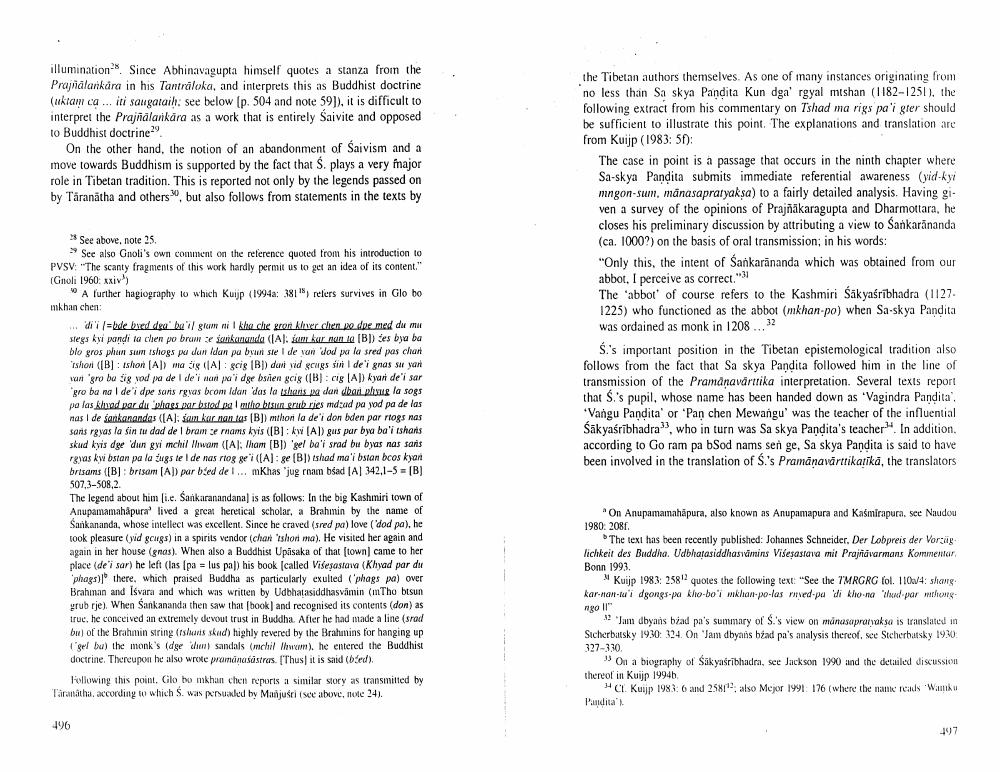Book Title: On Dates And Works Of Sankaranandana Author(s): Helmut Krasser Publisher: Helmut Krasser View full book textPage 5
________________ illumination. Since Abhinavagupta himself quotes a stanza from the Prajalankára in his Tantraloka, and interprets this as Buddhist doctrine (uktam ca ... iti saugataih: see below (p. 504 and note 59]), it is difficult to interpret the Prajalarikára as a work that is entirely Saivite and opposed to Buddhist doctrine On the other hand, the notion of an abandonment of Saivism and a move towards Buddhism is supported by the fact that S. plays a very inajor role in Tibetan tradition. This is reported not only by the legends passed on by Taranātha and others, but also follows from statements in the texts by See above, note 25 See also Gnoli's own comment on the reference quoted from his introduction to PVSV: "The scanty fragments of this work hardly permit us to get an idea of its content." Gnoli 1960: Axiv) A further hagiography to which Kuijp (1994a: 381") refers survives in Glo bo mkhan chen: dili/abide bred delul glum nil the che gran er den po doe med du ma slegs kyi prindi la chen po brun saukunanda (Allum kur mun (BD) Ses bya ba blo gros phan sum shogs i dan dan pu brun stel de vun dod par la sred pas chant Tshion (B) : Ishon (Alma (Algoig 1B)) dawl wid yngsti i de' gnas su van van gro besig vod pa del de' nan padge bien goig (B): cis (AD) kyuri de'i sar gro ba na I de idpe sans rgvas bcom Idan das la shans na dan ubac plus la sogs pa laskuad par du wars ar brod palmthe bun erub vies mdud pa yod pa de las nas I de sankanandas ((A): son kar man is (B]) mihon la de'i don bden par rtogs nas sans rgyas la sin tu dad de Ibram serams kyis ([B]: kw (Al) gus pur byu ba'i shans skud kyis dge 'dun gyi mchil Ihwam [A]: tham (B) 'gel ba'i srad bu byas nas sans rgias kwi stan pa laugs le I de nas rlog ge([A]: ge (B1) shod ma' bstan bcos kyan brisams [B] : brisam (Al) par bied de l... Khas 'jug roam bsad [A] 342.1-5 = [B] 507,3-508,2 The legend about him (ie. Sankaranandana) is as follows: In the big Kashmiri town of Anupamamahapura' lived a great heretical scholar, a Brahmin by the name of Sarkananda, whose intellect was excellent. Since he craved (sred pa) love (dod pa), he took pleasure (yid gaugs) in a spirits vendor (chart ishonma). He visited her again and again in her house (gros). When also a Buddhist Uplisaka of that (town) came to her place (de" sar) he left (las (pa = lus pal) his book (called Višeşastava (Khyad par due phags)] there, which praised Buddha as particularly exulted phags pa) over Brahman and Isvara and which was written by Udbhatasiddhasvamin (mTho bisun grub rje). When Sankananda then saw that book] and recognised its contents (don) as truche conceived an extremely devout trust in Buddha. After he had made a line (srad bu) of the Brahmin string shans skad) highly revered by the Brahmins for hanging up gel bu) the monk's (dge cu sandals (mchil Nrwam), he entered the Buddhist doctrine. Thereupon he also wrote promanasástras. [Thus it is said (ted). Following this point. Glo ho mkhan chen reports a similar story as transmitted by Taranátha, according to which S. was p aded by Manjusrisce above, note 24). the Tibetan authors themselves. As one of many instances originating from no less than Sa skya Pandita Kun dga' rgyal mtshan (1182-1251), the following extract from his commentary on Tshad ma rigs pa'i gler should be sufficient to illustrate this point. The explanations and translation are from Kuijp (1983: 5f): The case in point is a passage that occurs in the ninth chapter where Sa-skya Pandita submits immediate referential awareness (vid-ky mngon-sunn, manasapratyaksa) to a fairly detailed analysis. Having given a survey of the opinions of Prajñākaragupta and Dharmottara, he closes his preliminary discussion by attributing a view to Sankarananda (ca. 1000?) on the basis of oral transmission; in his words: "Only this, the intent of Sankarānanda which was obtained from our abbot, I perceive as correct "31 The 'abbot' of course refers to the Kashmiri Säkyaśrībhadra (1127. 1225) who functioned as the abbot (mkhan-po) when Sa-skya Pandita was ordained as monk in 1208....2 Si's important position in the Tibetan epistemological tradition also follows from the fact that Sa skya Pandita followed him in the line of transmission of the Pramanavar rika interpretation. Several texts report that Si's pupil, whose name has been handed down as 'Vagindra Pandita 'Vangu Pandita' or 'Panchen Mewangu' was the teacher of the influential Śäkyaśrībhadra", who in turn was Sa skya Pandita's teacher. In addition, according to Go ram pa bSod nams sen ge. Sa skya Pandita is said to have been involved in the translation of Si's Pramanavarttikatika, the translators "On Anupamamahapura, also known as Anupamapura and Kašmirapura. see Naudou 1980: 208. The text has been recently published: Johannes Schneider. Der Lobpreis der Vorzaglichkeit des Buddha. Udbhatasiddhasvamins Visesastava mil Prajridvarmans Kommentar Bonn 1993 Kuijp 1983: 258 quotes the following text: "See the TMRGRG fol. 110./4: shang. kar-nan-lui dgongs.pa kho-bo khanpo-las nuved-pa di kho na podpor ahorg no ir Jam dbyans biad pa's summary of Si's view on munasaproroksa is translated in Sicherbatsky 1930:324. On Jam dbyans bad pa's analysis thereof, see Stcherbatsky 19.30 327-330. On a biography of Sakyasribhadra, see Jackson 1990 and the detailed discussion thereof in Kuijp 1994 Ct. Kuijp 1983:6 and 251"also Mejor 1991 176 (where the man reads "Waltku. Pandita 196 197Page Navigation
1 ... 3 4 5 6 7 8 9 10 11
